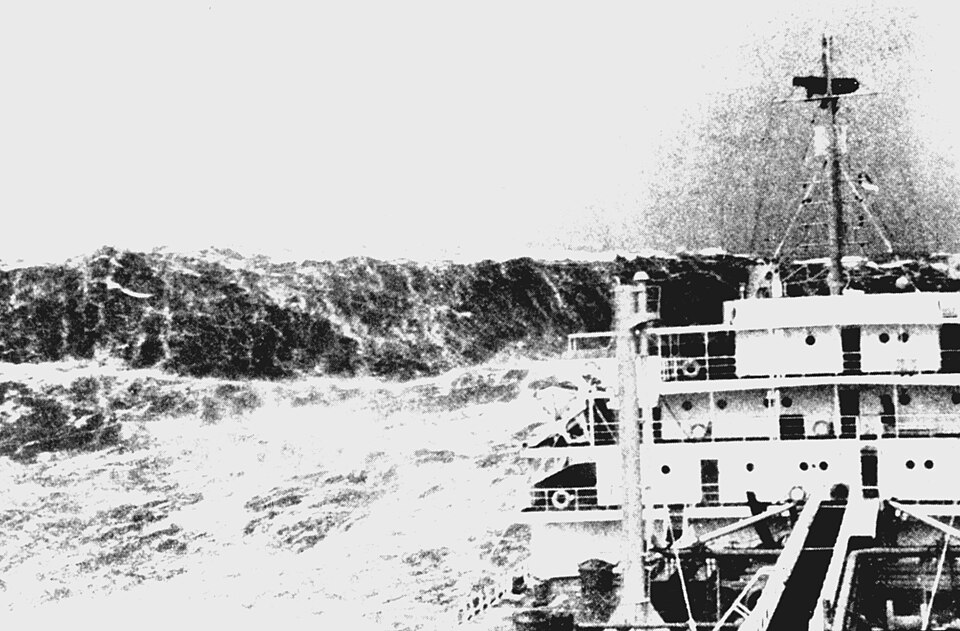
What causes rogue waves? There are many reasons why rogue waves can form but three of the most common theories are modulational instability, constructive interference, and another current. Tsunamis can be thought to be rogue waves, but they aren’t. They have a much longer wavelength.
The majority of the waves in the sea are caused by the energy from the wind. A stronger wind can make much bigger waves, but how long the wind can blow is also important. When the wind makes waves, there is something called fetch. This is the length of time that the wind can blow and push the waves without be interrupted or having a change in direction. Winds provide energy to the surface of the sea and the longer they can blow for, the more energy they can provide and the bigger the waves will be. The Pacific Ocean tends to have larger waves than any other sea because there is far more distance for the winds to blow without being interrupted.
Nobody knows how common rogue waves are, which means they are very difficult to study. This also means it is very difficult to workout what causes them. It is thought that they are probably fairly common, but we don’t encounter them that often, leading to their air of mystery. Rogue waves of over 20 meters have been measured. Modern ships are designed to survive them, but even modern ships can be damaged by the exceptionally big waves. Rogue waves usually don’t reach shore because they lose their energy and collapse long before that.
Tsunamis are sometimes mistaken for rogue waves. These are caused when there is a sudden and violent change in the level of the sea. This could be caused by a huge ice sheet sheering off, but it is more commonly caused by an earthquake at the bottom of the sea. The released energy from an earthquake can shunt the ground up a small amount, which moves a massive amount of water over it. This lifted water forms an energy wave that travels across the sea, but it is not a rogue wave. It doesn’t lose its power when it hits land, but the higher sea level can carry the water far inland.
Another explanation for rogue waves is a process called modulational instability. This is where one wave absorbs energy from the waves around it. Through this process, the one wave gets higher and the other waves get smaller. This can make the difference between the rogue wave and the surrounding waves even larger. One of the waves becomes unstable and starts to oscillate back and forth. As it does so, it slowly takes energy from the wave in front and the wave behind, growing in the process. Once these waves are gone, it takes energy from the next set of waves. This could make a wave grow very high, but it would be very unstable and not last very long before collapsing.
Another theory is constructive interference. We looked at this when we learned about noise cancelling headphones. A wave of anything has peaks and troughs. If you put two waves together, you can have constructive interference and destructive interference. Destructive interference is how noise cancelling headphones work. The headphones record the surrounding sound and play it back, but reversed. When this happens, the peaks of one wave coincide with the troughs of the other wave and they cancel each other out, destroying the wave. When you have constructive interference, the two waves are in sync, with the peaks and the troughs inline with each other. When this happens, the waves add to each other, making the peaks higher and the troughs lower. This could be the cause for a rogue wave, but instead of all of the waves being in sync and multiplying, only one part is in sync and that causes just one wave to multiply.
Another cause for rogue waves could be colliding currents. In some parts of the sea, one current is on the surface travelling in one direction and there is another current deeper down that is going in the opposite direction. When this happens it might produce a process known as shoaling. This is the same thing that happens when a wave nears the shore. When a wave approaches the shore, the sea gets shallower and the height of the wave above the sea level increases because it is pushed up. The same thing happens when a wave meets and opposing current. It will push the waves above the surface, occasionally producing rogue waves. And this is what I learned today.
Sources
https://en.wikipedia.org/wiki/Rogue_wave
https://en.wikipedia.org/wiki/Modulational_instability
https://oceanservice.noaa.gov/facts/roguewaves.html
https://manoa.hawaii.edu/exploringourfluidearth/physical/waves/sea-states/weird-science-rogue-waves
